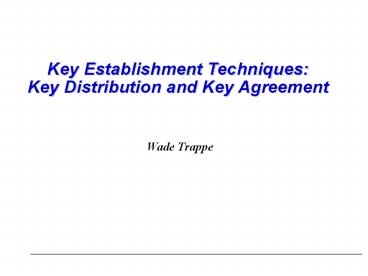Key Establishment Techniques: Key Distribution and Key Agreement - PowerPoint PPT Presentation
Title:
Key Establishment Techniques: Key Distribution and Key Agreement
Description:
Can be extended to arbitrary radix b using Ingemarsson as the basic building block. ... Optimal radix in both cases is 2. The Conference Tree ... – PowerPoint PPT presentation
Number of Views:270
Avg rating:3.0/5.0
Title: Key Establishment Techniques: Key Distribution and Key Agreement
1
Key Establishment TechniquesKey Distribution
and Key Agreement
- Wade Trappe
2
Key Establishment The problem
- Securing communication requires that the data is
encrypted before being transmitted. - Associated with encryption and decryption are
keys that must be shared by the participants. - The problem of securing the data then becomes the
problem of securing the establishment of keys. - Task If the participants do not physically meet,
then how do the participants establish a shared
key? - Two types of key establishment
- Key Agreement
- Key Distribution
3
Key Distribution
- Key Agreement protocols the key isnt determined
until after the protocol is performed. - Key Distribution protocols one party generates
the key and distributes it to Bob and/or Alice
(Shamirs 3pass, Kerberos). - Shamirs Three-Pass Protocol
- Alice generates and Bob generates
. - A key K is distributed by
4
Basic TTP Key Distribution
KDC
Kb
Ka
1. A Sends Request IDA IDB N1
2. KDC Sends EKa KAB Request IDA IDB
N1EKb(KAB, IDA)
3. A Sends EKb(KAB, IDA)
4. B Sends EKAB(N2)
5. A Sends EKAB(f(N2))
5
Key Agreement
- In many scenarios, it is desirable for two
parties to exchange messages in order to
establish a shared secret that may be used to
generate a key. - The Diffie-Hellman (DH) protocol is a basic tool
used to establish shared keys in two-party
communication. - Two parties, A and B, establish a shared secret
by - The security of the DH scheme is based upon the
intractibility of the Diffie-Hellman Problem - The Diffie-Hellman scheme can be extended to work
on arbitrary groups (e.g. Elliptic Curves).
6
Intruder In The Middle
- The Intruder-in-the-Middle attack on
Diffie-Hellman is based upon the following
strategy to improve ones chess ranking - Eve challenges two grandmasters, and uses GM1s
moves against GM2. Eve can either win one game,
or tie both games. - Eve has and can perform the
Intruder-in-the-Middle attack by
Alice
Bob
Eve
Decrypts data with KAE, uses data and encrypts
with KBE
Decrypts data with KBE
7
Station-to-Station Protocol
- Digital signatures can be used to prevent this
protocol failure (STS Protocol). - A digital signature is a scheme that ties a
message and its author together. - Private sig( ) function and Public ver( )
function.
Verifies sig
Verifies sig
8
N-to-N Group Key Establishment
- Many group scenarios require contributory key
establishment protocols. - 1-to-1 Key Establishment Diffie-Hellman (DH)
protocol - Two parties, A and B, establish a shared secret
by - Extensions to multi-user scenarios
- Ingemarsson Requires N-1 rounds and O(N2)
exponentiations - Burmester-Desmedt Requires 2 rounds but full
broadcast - GDH (Steiner et al.) Requires N rounds and O(N)
exp.
9
Butterfly Group Diffie-Hellman
Example
u1
u2
u3
u4
- Can be extended to arbitrary radix b using
Ingemarsson as the basic building block. - Total Rounds
- Total Messages
- Optimal radix in both cases is 2.
u5
u6
u7
u8
10
The Conference Tree
- Group key formation procedure is described by
- Communication flow diagram
- Conference Tree
- Conference tree describes the subgroups and
subgroup keys.
u1
u2
u3
u4
u5
u6
u7
K101
K001
K011
K100
K110
K000
K010
K111
u8
11
Making Primes
- Fact Let n be an odd prime and let
, where r is odd. Let a be any integer such that
gcd(a,n)1. Then either or
for some . - Definition Let n be an odd composite with
. Let - . If either
or , for some
then n is a strong pseudoprime
base a, and a is a strong liar for n. - Fact If n is an odd composite integer, then at
most 1/4 of the numbers a are strong liars for
n. - We can use this in a Monte-Carlo algorithm to
produce primes - Test t different as.
- Probability of falsely identifying a prime is































